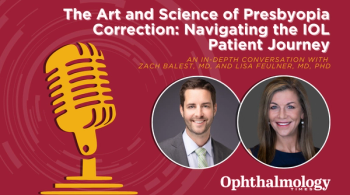
System augments LASIK outcomes for mixed astigmatism
Chicago—Wavefront-guided CustomCornea LASIK using the LADARVision 4000 Excimer Laser System (Alcon Laboratories) safely and effectively treats mixed astigmatism and with some advantages compared with conventional LASIK, said James J. Salz, MD, at the refractive surgery subspecialty day meeting sponsored by the International Society of Refractive Surgery of the American Academy of Ophthalmology.
Speaking on behalf of the CustomCornea Study Group, Dr. Salz presented the 6-month results from 110 eyes treated with the wavefront-guided LASIK procedure. In addition, he reported findings from a comparative substudy between 83 eyes treated with CustomCornea LASIK and a control group of 26 eyes having a similar preoperative refractive range that were treated under the same protocol with conventional LASIK.
The uncorrected visual acuity (UCVA) and refractive outcomes were excellent for CustomCornea treatment, and the results were similar when comparing the overall and substudy CustomCornea populations. The substudy further supported CustomCornea treatment in evaluation of high-contrast and low-contrast best spectacle-corrected visual acuity (BSCVA) gain versus loss and higher-order aberrations from preoperative.
All treatments were performed using the LADARVision 4000 System over a 6.5-mm optical zone with a 1.25-mm peripheral blend zone. Conventional LASIK was based on cycloplegic refraction. CustomCornea LASIK was based on measurements of up to sixth-order higher-order aberrations using Alcon's LADARWave aberrometer. Wavefronts were measured in the dilated eye to ensure capture of aberrations occurring in the periphery (e.g., spherical aberration) that would otherwise not be fully measurable in the undilated eye. Laser ablation was applied onto the exact corneal position that is matched to the wavefront measurement. For an individual eye, the center of laser ablation corresponds to the center of the undilated pupil with registration to fixed limbal and reticle references that were maintained throughout the ablation.
At 6 months, 100% of the enrolled eyes were available. For the overall CustomCornea cohort, UCVA was 20/20 or better in 64% of eyes while 87% had 20/25 or better and 98% had 20/40 or better UCVA. Considering the CustomCornea subgroup of 94 eyes with preoperative BSCVA of 20/20 or better, 71% achieved UCVA of 20/20 or better.
In the substudy, again considering eyes with preoperative BSCVA of 20/20 or better, UCVA of 20/20 or better was achieved by 73% of eyes treated with CustomCornea LASIK compared with 65% of those treated with conventional LASIK.
For accuracy of MRSE, 76% of eyes for the overall CustomCornea cohort were within 0.5 D of emmetropia and 91% were within 1 D of emmetropia. For the substudy, 81% of eyes undergoing CustomCornea LASIK were within 0.5 D of emmetropia compared with only 65% of those undergoing conventional LASIK. Vector analysis showed the two techniques offered similar effectiveness in astigmatism treatment that averaged about 90% correction of manifest cylinder for the overall CustomCornea cohort and both substudy populations.
Newsletter
Don’t miss out—get Ophthalmology Times updates on the latest clinical advancements and expert interviews, straight to your inbox.


















































.png)


